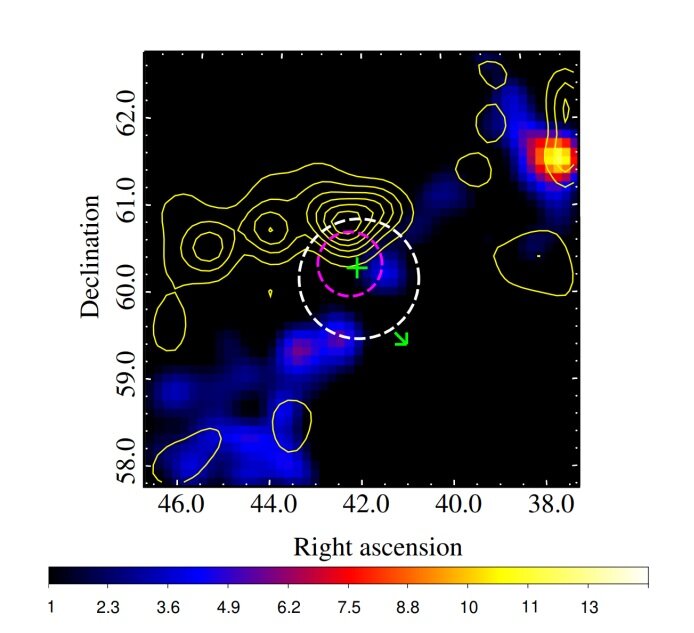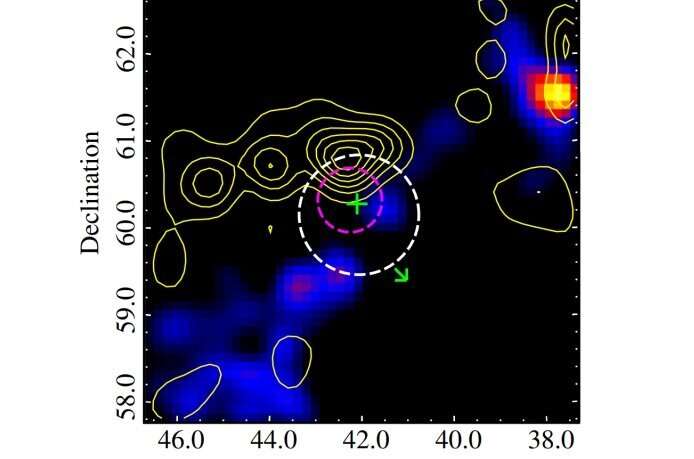

Using the Large High-Altitude Air Shower Observatory (LHAASO), an international team of astronomers have detected very-high-energy (VHE) gamma-rays around the pulsar PSR J0248+6021, which may be the pulsar’s halo or a pulsar wind nebula. The finding was reported in a paper published October 6 on the pre-print server arXiv.
Pulsars are highly magnetized, rotating neutron stars emitting a beam of electromagnetic radiation. They are usually detected in the form of short bursts of radio emission; however, some of them are also observed via optical, X-ray and gamma-ray telescopes.
Sources emitting gamma radiation with photon energies between 100 GeV and 100 TeV are called very-high energy (VHE) gamma-ray sources, while those with photon energies above 0.1 PeV are known as ultra-high energy (UHE) gamma-ray sources. The nature of these sources is still not well understood; therefore, astronomers are constantly searching for new objects of this type to characterize them, which could shed more light on their properties in general.
Discovered in 1997, PSR J0248+6021 is a middle-aged pulsar with a rotation period of approximately 217 milliseconds and spin-down power at a level of 213 decillion erg/s. The pulsar has an unusually high dispersion measure of about 370 pc/cm3, which is most likely due to its location within the dense giant region of ionized atomic hydrogen (HII region), designated W5, at a distance of some 6,500 light years.
Now, a team of astronomers led by Zhen Cao of the Chinese Academy of Sciences (CAS) reports the detection of VHE gamma-ray emission located close to the position of PSR J0248+6021. The finding is based on the data from LHAASO’s Water Cherenkov Detector Array (WCDA).
By analyzing the WCDA data, Cao’s team identified three gamma-ray sources out of which two are close to PSR J0248+6021 based on their angular distance. One of them turned out to be an extended source consistent with 1LHAASO J0249+6022 reported in the first LHAASO catalog, while the other one is a point source with an angular distance of approximately 1.2 degrees from the pulsar.
According to the paper, no clear extended multiwavelength counterpart of 1LHAASO J0249+6022 has been found from radio to GeV bands. Therefore, the authors of the paper concluded that the most plausible explanation of the detected VHE gamma-ray emission is the inverse Compton process of highly relativistic electrons and positrons injected by PSR J0248+6021.
The astronomers noted that the morphology of the VHE gamma-ray emission suggests that 1LHAASO J0249+6022 is the TeV pulsar halo or a pulsar wind nebula associated with PSR J0248+6021.
“These electrons/positrons are hypothesized to be either confined within the pulsar wind nebula or to have already escaped into the interstellar medium, forming a pulsar halo,” the researchers concluded.
More information:
Zhen Cao et al, LHAASO detection of very-high-energy gamma-ray emission surrounding PSR J0248+6021, arXiv (2024). DOI: 10.48550/arxiv.2410.04425
Journal information:
arXiv
© 2024 Science X Network
Citation:
Astronomers detect very-high-energy gamma-ray emission surrounding distant pulsar (2024, October 15)
retrieved 15 October 2024
from https://phys.org/news/2024-10-astronomers-high-energy-gamma-ray.html
This document is subject to copyright. Apart from any fair dealing for the purpose of private study or research, no
part may be reproduced without the written permission. The content is provided for information purposes only.